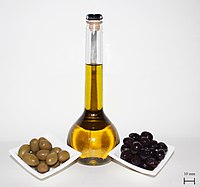
Photo from wikipedia
Cardiovascular diseases represent the principal cause of morbidity and mortality worldwide. It is well-known that oxidative stress and inflammatory processes are strongly implicated in their pathogenesis; therefore, anti-oxidant and anti-inflammatory… Click to show full abstract
Cardiovascular diseases represent the principal cause of morbidity and mortality worldwide. It is well-known that oxidative stress and inflammatory processes are strongly implicated in their pathogenesis; therefore, anti-oxidant and anti-inflammatory agents can represent effective tools. In recent years a large number of scientific reports have pointed out the nutraceutical and nutritional value of extra virgin olive oils (EVOO), strongholds of the Mediterranean diet, endowed with a high nutritional quality and defined as functional foods. In regard to EVOO, it is a food composed of a major saponifiable fraction, represented by oleic acid, and a minor unsaponifiable fraction, including a high number of vitamins, polyphenols, and squalene. Several reports suggest that the beneficial effects of EVOO are linked to the minor components, but recently, further studies have shed light on the health effects of the fatty fraction and the other constituents of the unsaponifiable fraction. In the first part of this review, an analysis of the clinical and preclinical evidence of the cardiovascular beneficial effects of each constituent is carried out. The second part of this review is dedicated to the main operating conditions during production and/or storage that can directly influence the shelf life of olive oil in terms of both nutraceutical properties and sensory quality.
Journal Title: Nutrients
Year Published: 2019
Link to full text (if available)
Share on Social Media: Sign Up to like & get
recommendations!